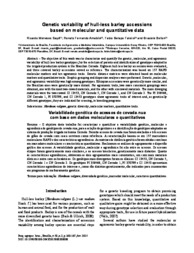Genetic variability of hull-less barley accessions based on molecular and quantitative data.
Genetic variability of hull-less barley accessions based on molecular and quantitative data.
Author(s): SAYD, R. M.; AMABILE, R. F.; FALEIRO, F. G.; BELLON, G.
Summary: Abstract - The objective of this work was to characterize and quantify the genetic, molecular, and agronomic variability of hull-less barley genotypes, for the selection of parents and identification of genotypes adapted to the irrigated production system in the Brazilian Cerrado. Eighteen hull-less barley accessions were evaluated, and three covered barley accessions served as reference. The characterization was based on 157 RAPD molecular markers and ten agronomic traits. Genetic distance matrices were obtained based on molecular markers and quantitative traits. Graphic grouping and dispersion analyses were performed. Genetic, molecular, and agronomic variability was high among genotypes. Ethiopian accessions were genetically more similar, and the Brazilian ones were genetically more distant. For agronomic traits, two more consistent groupings were obtained, one with the most two-rowed materials, and the other with six-rowed materials. The more diverging materials were the two-rowed CI 13453, CN Cerrado 5, CN Cerrado 1, and CN Cerrado 2. The PI 356466, CN Cerrado 1, PI 370799, and CI 13453 genotypes show agronomic traits of interest and, as genetically different genotypes, they are indicated for crossing, in breeding programs. Resumo - O objetivo deste trabalho foi caracterizar e quantificar a variabilidade genética, molecular e agronômica de genótipos de cevada-nua, para a seleção de genitores e a identificação de genótipos adaptados ao sistema de produção irrigada no bioma Cerrado. Dezoito acessos de cevada-nua foram avaliados e três acessos de grãos de cevada com casca serviram como referência. A caracterização baseou-se em 157 marcadores moleculares RAPD e dez características agronômicas. As matrizes de distância genética foram obtidas com base em marcadores moleculares e características quantitativas. Realizaram-se análises de agrupamento e dispersão gráfica dos acessos. A variabilidade genética, molecular e agronômica foi alta entre os acessos. Os acessos etíopes foram geneticamente mais similares, e os acessos brasileiros, geneticamente mais distantes. Quanto às características agronômicas, obtiveram-se dois agrupamentos mais consistentes, um com mais materiais dísticos e outro com os hexásticos. Os genótipos mais divergentes foram os dísticos CI 13453, CN Cerrado 5, CN Cerrado 1 e CN Cerrado 2. Os genótipos PI 356466, CN Cerrado 1, PI 370799 e CI 13453 apresentam características agronômicas de interesse e, como são distintos geneticamente, são indicados para cruzamentos em programas de melhoramento genético.
Publication year: 2015
Types of publication: Journal article
Unit: Embrapa Cerrados
Observation
Some of Embrapa's publications are published as ePub files. To read them, use or download one of the following free software options to your computer or mobile device. Android: Google Play Books; IOS: iBooks; Windows and Linux: Calibre.
Access other publications
Access the Agricultural Research Database (BDPA) to consult Embrapa's full library collection and records.
Visit Embrapa Bookstore to purchase books and other publications sold by Embrapa.

